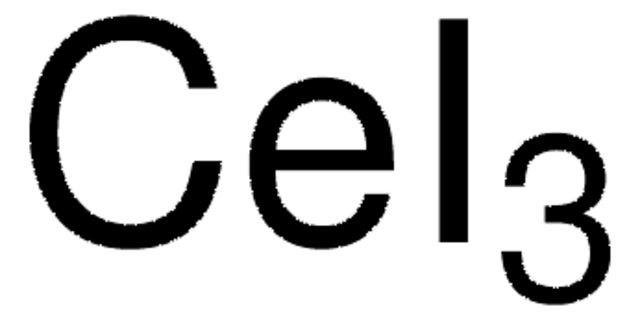466360
Zinc iodide
anhydrous, powder, 99.999% trace metals basis
Sinonimo/i:
Diiodozinc, Zinc diiodide
About This Item
Prodotti consigliati
Grado
anhydrous
Saggio
99.999% trace metals basis
Forma fisica
powder
Impiego in reazioni chimiche
reagent type: catalyst
core: zinc
Impurezze
≤15.0 ppm Trace Metal Analysis
Punto di fusione
445 °C (lit.)
Densità
4.74 g/mL at 25 °C (lit.)
Stringa SMILE
I[Zn]I
InChI
1S/2HI.Zn/h2*1H;/q;;+2/p-2
UAYWVJHJZHQCIE-UHFFFAOYSA-L
Cerchi prodotti simili? Visita Guida al confronto tra prodotti
Accessorio
Avvertenze
Warning
Indicazioni di pericolo
Consigli di prudenza
Classi di pericolo
Aquatic Acute 1 - Aquatic Chronic 1 - Eye Irrit. 2 - Skin Irrit. 2 - STOT RE 2 Oral
Organi bersaglio
Thyroid
Codice della classe di stoccaggio
13 - Non Combustible Solids
Classe di pericolosità dell'acqua (WGK)
WGK 3
Punto d’infiammabilità (°F)
Not applicable
Punto d’infiammabilità (°C)
Not applicable
Dispositivi di protezione individuale
Eyeshields, Faceshields, Gloves, type P3 (EN 143) respirator cartridges
Certificati d'analisi (COA)
Cerca il Certificati d'analisi (COA) digitando il numero di lotto/batch corrispondente. I numeri di lotto o di batch sono stampati sull'etichetta dei prodotti dopo la parola ‘Lotto’ o ‘Batch’.
Possiedi già questo prodotto?
I documenti relativi ai prodotti acquistati recentemente sono disponibili nell’Archivio dei documenti.
I clienti hanno visto anche
Articoli
Colloidal quantum dots (CQDs) are semiconducting crystals of only a few nanometers (ca. 2–12 nm) coated with ligand/surfactant molecules to help prevent agglomeration.
Il team dei nostri ricercatori vanta grande esperienza in tutte le aree della ricerca quali Life Science, scienza dei materiali, sintesi chimica, cromatografia, discipline analitiche, ecc..
Contatta l'Assistenza Tecnica.











